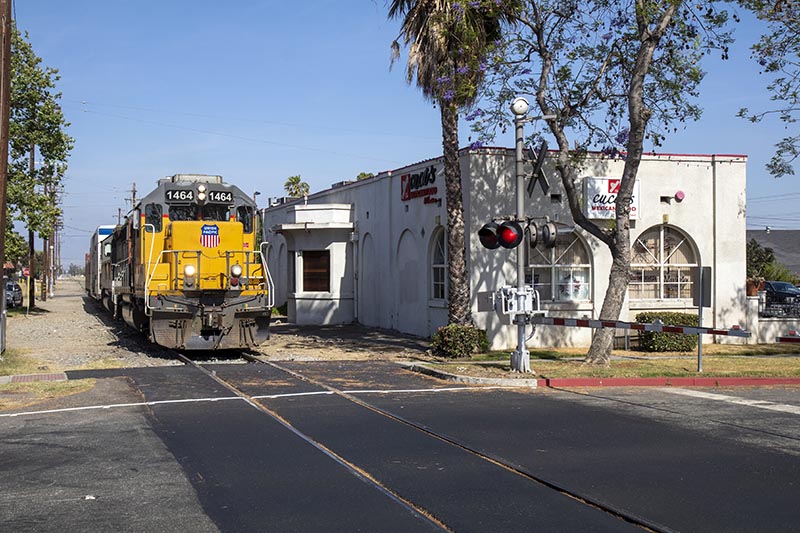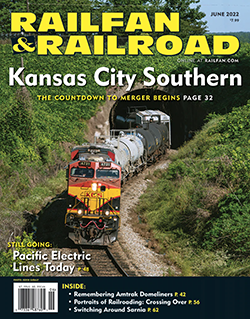 By Charles Freericks/photos by the author
By Charles Freericks/photos by the author
Tuesday morning the radio scanner crackles in downtown Los Angeles — “El Segundo Local calling San Gabriel Sub DS” — as the Union Pacific LOW20 job requests permission to enter Metrolink-controlled trackage. Soon, a heavily graffitied GP60 and GP40-2 roll their string of grain hoppers and petroleum tanks on a 17-mile voyage through South LA to the South Bay. The train will pass through some of the most dangerous neighborhoods in America, only to finish its westward run in one of the toniest.
Most of that trek will be along erstwhile Pacific Electric right-of-way, the same route over which freight has been pulled since 1914, when El Segundo (Spanish for “the second”) was established as Standard Oil’s second California refinery.
You may have thought that Pacific Electric was obliterated long ago, but pieces of the mighty Big Red Car empire still exist. True, most of what was once the largest interurban railroad in America has vanished, yet there are still a surprising number of PE lines in use today. And while the iconic Hollywood Cars no longer roll along Santa Monica Boulevard in Beverly Hills, there are heavily patronized light rail lines to Santa Monica, Long Beach, and other locales that you can ride over PE right-of-way in 2022. There are freight trains of both Union Pacific and Pacific Harbor Line switching PE spurs. And there are Metrolink commuter trains racing on PE tracks. There may no longer be a Pacific Electric, but the energy of Henry Huntington’s electric empire still sizzles in surprising ways.
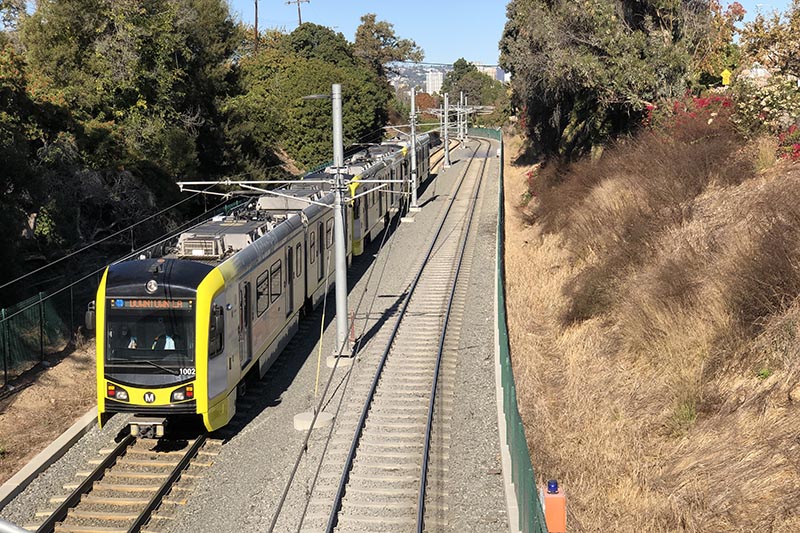
ABOVE: Metro Rail runs frequent service on the “E” Line (formerly the Expo Line). A set of Kinki Sharyo P3010 cars heads through a cut in Rancho Park, a few miles into its run from Santa Monica to downtown Los Angeles over the erstwhile PE Santa Monica Air Line on November 24, 2019.
It was that very energy that built the sprawling greater Los Angeles of today. As the 19th century drew to a close, Huntington began buying disparate electric railroads. He then built additional lines east, south, and west, to eventually create the largest interurban in the U.S.
At the same time, Huntington bought much of the land around his new rail lines, subdividing it for those looking to live the California dream. By the early 1900s, Pacific Electric reached as far as Redlands and Newport Beach. By 1910, Southern Pacific saw Pacific Electric as a threat and bought out Huntington. One year later, SP merged all the remaining interurban lines in Southern California together, bringing the Big Red Cars to West LA and the San Fernando Valley. By December 1916 (when the author’s great-grandfather opened a drug store called The P.E. Pharmacy in Pacific Electric’s San Bernardino depot), the railroad ran 6,200 electric trains a day over 1,061 miles of right-of-way.
But it wasn’t to last. Less than 40 years later, a good deal of the passenger system had been abandoned in favor of automobiles and the promise of new freeways. In 1953, what remained was sold off to Metropolitan Coach Lines, only to be completely abolished when the last Big Red Car revenue run was made on April 9, 1961.
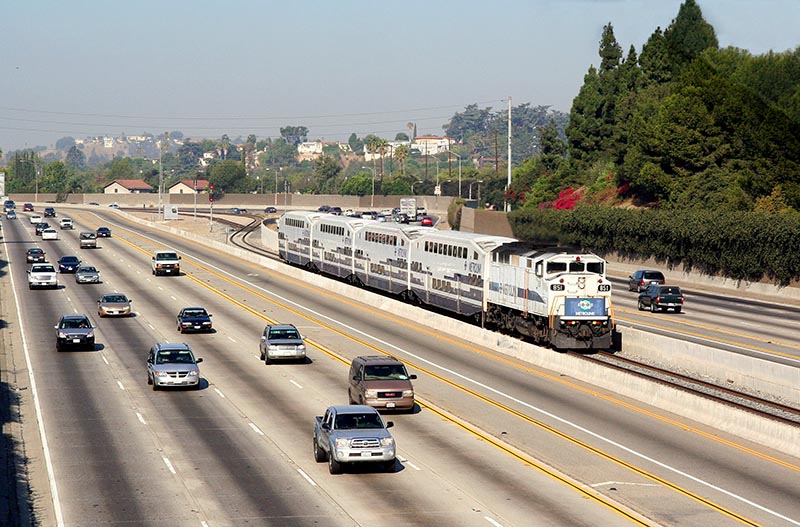
ABOVE: One of the most unusual examples of surviving PE lines is a section of Metrolink’s San Gabriel Sub that runs down the middle of Interstate 10 (San Bernardino Freeway) east of Los Angeles. On September 16, 2007, a weekend San Bernardino train catches the drivers’ attention.
Life After Electric
The always-profitable freight traffic did keep a part of Pacific Electric viable through its absorption into Southern Pacific in 1964. And yet, as industry vanished throughout Southern California, even those once profitable freight lines began to shrivel and rust. The 1970s saw rail service disappear in Hollywood and Beverly Hills, among many other towns. The 1980s saw rail service shutter in Santa Monica and Culver City. The future looked grim.
That was until intermodal traffic came to the Ports of Los Angeles and Long Beach and light rail and commuter trains came to the Los Angeles Basin; suddenly, those rusty rails were needed again.
Today, there are approximately 14 Pacific Electric lines in active service (depending on how you count them, and honestly, one could make an argument for there being 10 or 20 just as easily, by using historic delineations instead of the modern-day ones). There are also bits and pieces of additional lines still in use, such as a small section of the Redondo Beach via Gardena Line that exists as a spur into a lumberyard in Gardena, and a small section of the Santa Ana Line that accesses a tank-car customer in Paramount.
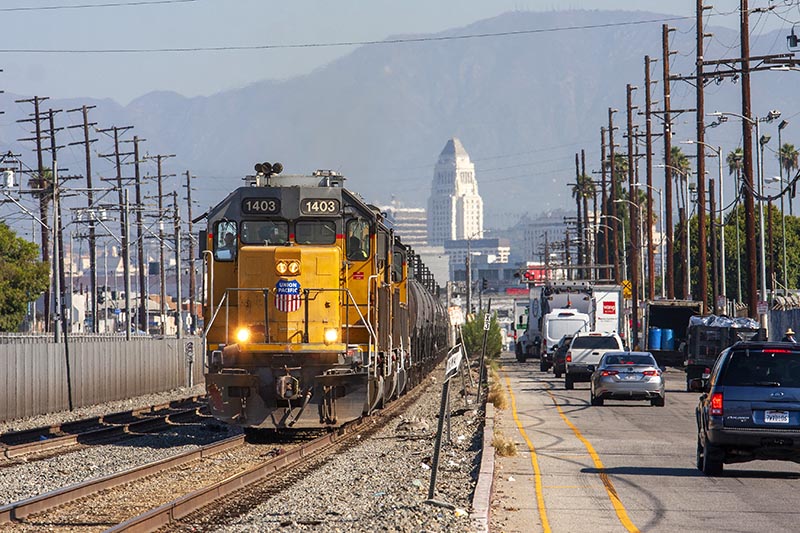
ABOVE: In what has become the classic shot of trains running down Pacific Electric’s former four-track main, the August 27, 2019, version of the LOW10 Torrance Local strikes a rolling pose with Los Angeles City Hall rising in the background.
One could even contend that some of the Metro Rail subway through the Cahuenga Pass follows Pacific Electric right-of-way, as does as the Metro bus rapid transit line’s first few miles west of North Hollywood; for this article, we’ll stick with at-grade or briefly grade-separated rail operations on the right-of-way. Finally, by these methods, there will be a 15th Pacific Electric line added back soon when the OC Streetcar opens in 2023 utilizing part of the Pacific Electric Santa Ana Line…


